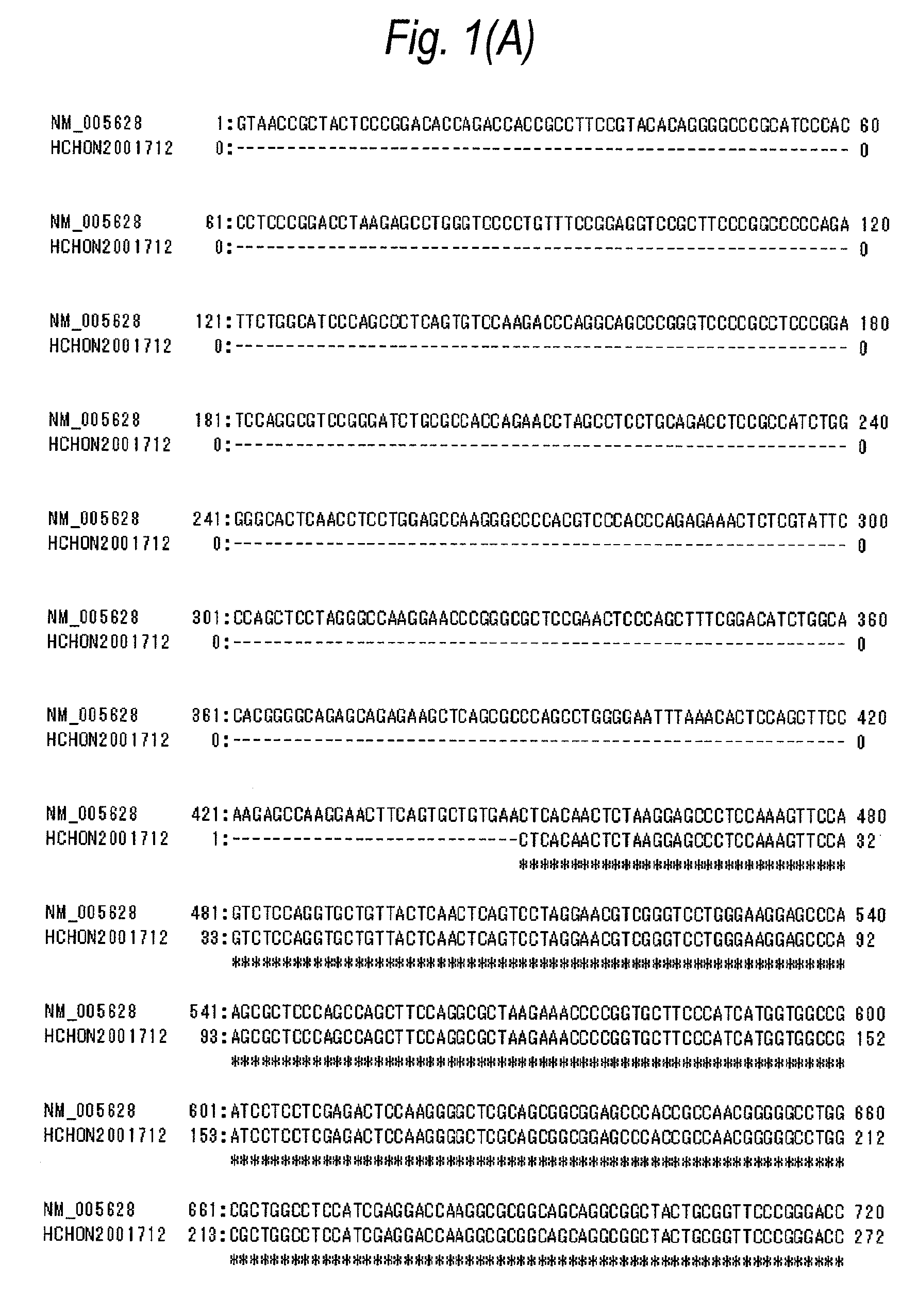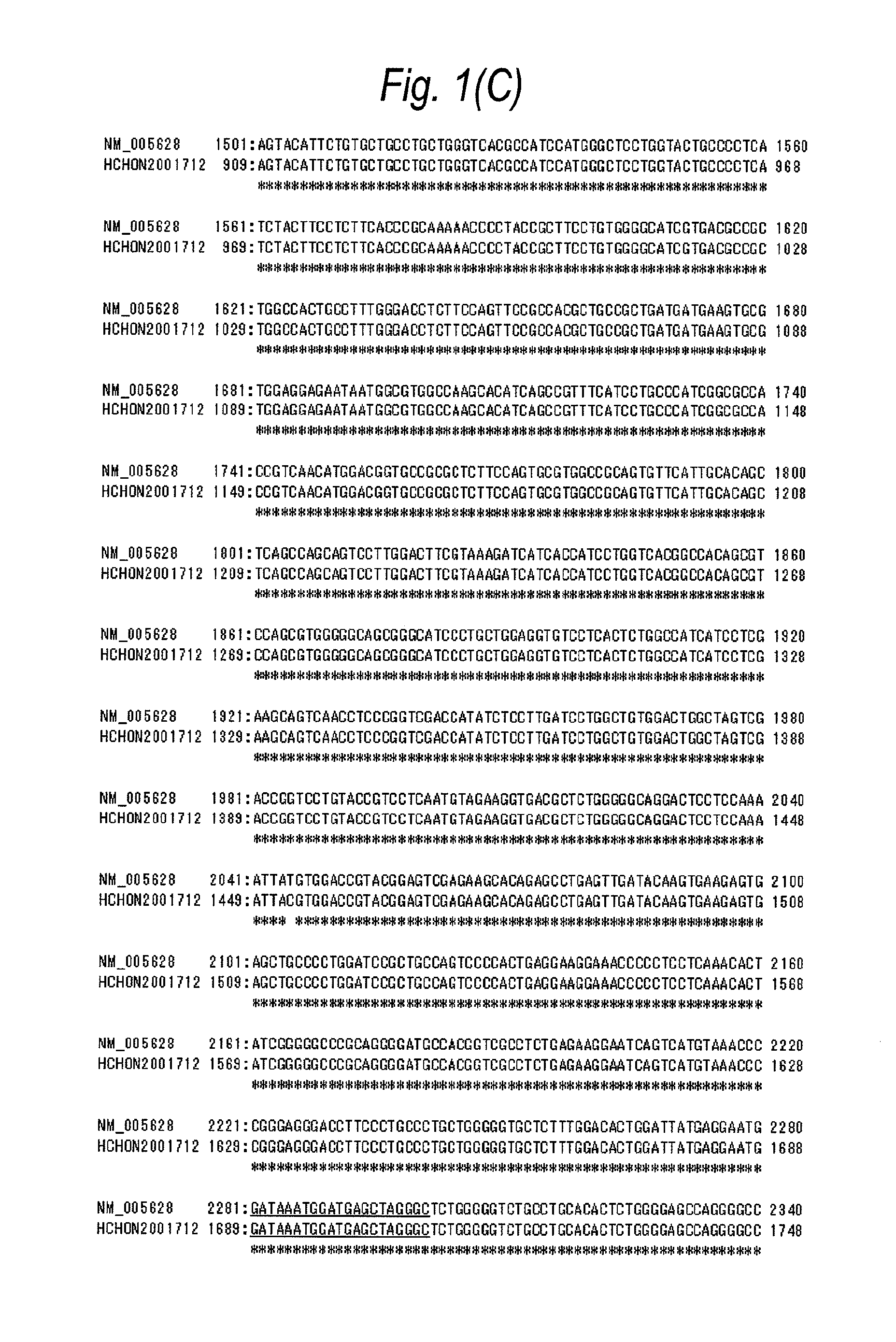Anti system asc amino acid transporter 2 (ASCT2) antibody
a technology of asct2 and amino acid transporter, which is applied in the field of monoclonal antibodies, can solve the problems of inability to inhibit the intracellular uptake of amino acids by asct2 which expresses in living cells, and cell cytotoxicities due to effector activity cannot be expected
- Summary
- Abstract
- Description
- Claims
- Application Information
AI Technical Summary
Benefits of technology
Problems solved by technology
Method used
Image
Examples
example 1
Analysis of ASCT2 Gene Expression in Various Cell Lines, Xenografts, and Normal Tissues
[0364](1) Construction of Xenografts with Subcutaneous Transplantation of a Cancer Cell Line into SCID Mice and Preparation of Tumor Mass
[0365]In accordance with the following procedure, human cancer cell lines were subcutaneously transplanted into SCID mice to thereby construct xenografts. A tumor mass was extracted and prepared from the resulting xenografts.
[0366]Human pancreatic cancer cell lines [ASPC-1 (ATCC Accession No. CRL-1682), CaPan-1 (ATCC Accession No. HTB-79), PANC-1 (ATCC Accession No. CRL-1469)], and human colorectal cancer cell lines [Colo205 (Riken (Physicochemical Research Institute) Cell Bank No. RCB2127), HT-29 (ATCC Accession No. HTB-38), LS180 (ATCC Accession No. CCL-187), SW1116 (ATCC Accession No. CCL-233), and WiDr (ATCC Accession No. CCL-218)] were suspended in PBS to give a cell density of about 1×108 cells / mL. Into the ventral hypodermis of 4 Fox CHASE C.B-17 / Icr-scidJ...
example 2
Construction of CHO Cell Line Introducing Human ASCT2-myc / His Gene
[0398]In accordance with the following procedure, a plasmid pCR4-SLC1A5-myc / His was obtained comprising the nucleotide sequence shown in SEQ ID NO:5 and the amino acid sequence shown in SEQ ID NO:6. Using this plasmid, a CHO cell line into which the human ASCT2-myc / His gene was introduced was obtained.
[0399]To the respective primers (10 μmol / L, each 1 μL) comprising each of the nucleotide sequences of SEQ ID NOs:7 to 10, 10×Ex Taq buffer (10 μL), dNTPs (2 mmol / L, 10 μL), and Ex Taq polymerase (1 μL, all manufactured by Takara Bio) were added, and sterile water was further added thereto to give a total volume of 100 μL.
[0400]In a manner similar to the procedure described in Example 1(C), PCR was carried out under the following reaction conditions: reaction at 96° C. for 2 minutes, and then 35 cycles each consisting of three processes, reaction at 96° C. for 1 minute, reaction at 60° C. for 1 minute, and reaction at 72°...
example 3
Construction of Monoclonal Antibody Against N-Terminal Partial Peptide of ASCT2
[0421](1) Preparation of Immunogen
[0422]For binding to a carrier protein, an N-terminal partial peptide of the human ASCT2 gene shown in SEQ ID NO:14 (amino acid residues at positions 2 to 16 from the N-terminal) in which Cys was added to the C-terminal was synthesized using an automated synthesizer (PSSM-8, manufactured by Shimadzu).
[0423]In order to enhance the immunogenity, a conjugate with KLH (manufactured by Wako Pure Chemical) was prepared as follows and used as an immunogen. That is, KLH was dissolved in PBS to give a concentration of 10 mg / mL and a 1 / 10 volume of N-(m-maleimide benzoyloxy)succinimide (MBS, manufactured by Nacalai Tesque, 25 mg / mL) was then added thereto dropwise, followed by reaction under stirring for 30 minutes.
[0424]The reaction solution was passed through a gel filtration column (Sephadex G-25 column, manufactured by GE Healthcare) which had been previously equilibrated with ...
PUM
| Property | Measurement | Unit |
|---|---|---|
| pH | aaaaa | aaaaa |
| pH | aaaaa | aaaaa |
| particle size | aaaaa | aaaaa |
Abstract
Description
Claims
Application Information
 Login to View More
Login to View More - R&D
- Intellectual Property
- Life Sciences
- Materials
- Tech Scout
- Unparalleled Data Quality
- Higher Quality Content
- 60% Fewer Hallucinations
Browse by: Latest US Patents, China's latest patents, Technical Efficacy Thesaurus, Application Domain, Technology Topic, Popular Technical Reports.
© 2025 PatSnap. All rights reserved.Legal|Privacy policy|Modern Slavery Act Transparency Statement|Sitemap|About US| Contact US: help@patsnap.com



